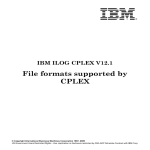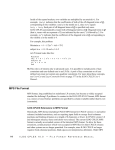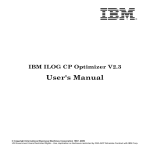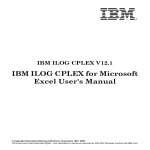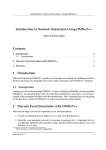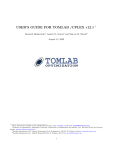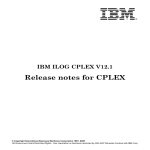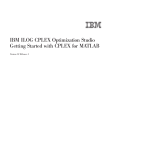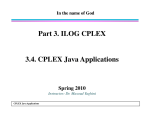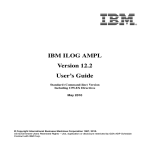Download ILOG CPLEX 10.0 File Formats
Transcript
ILOG CPLEX 10.0 File Formats
January 2006
COPYRIGHT NOTICE
Copyright © 1987-2006, by ILOG S.A. and ILOG, Inc. All rights reserved.
General Use Restrictions
This document and the software described in this document are the property of ILOG and
are protected as ILOG trade secrets. They are furnished under a license or nondisclosure
agreement, and may be used or copied only within the terms of such license or nondisclosure
agreement.
No part of this work may be reproduced or disseminated in any form or by any means,
without the prior written permission of ILOG S.A, or ILOG, Inc.
Trademarks
ILOG, the ILOG design, CPLEX, and all other logos and product and service names of
ILOG are registered trademarks or trademarks of ILOG in France, the U.S. and/or other
countries.
All other company and product names are trademarks or registered trademarks of their
respective holders.
Java and all Java-based marks are either trademarks or registered trademarks of Sun
Microsystems, Inc. in the United States and other countries.
Microsoft and Windows are either trademarks or registered trademarks of Microsoft
Corporation in the United States and other countries.
document version 10.0
Table of Contents
ILOG CPLEX File Formats . . . . . . . . . . . . . . . . . . . . . . . . . . . . . . . . . . . . . . . . . . . . . . . . . . . . . . . . . 5
Brief Descriptions of File Formats . . . . . . . . . . . . . . . . . . . . . . . . . . . . . . . . . . . . . . . . . . . . . . 6
Entering Problems in the Interactive Optimizer . . . . . . . . . . . . . . . . . . . . . . . . . . . . . . . . . . . 8
Saving Problems in the Interactive Optimizer. . . . . . . . . . . . . . . . . . . . . . . . . . . . . . . . . . . . . 8
LP File Format . . . . . . . . . . . . . . . . . . . . . . . . . . . . . . . . . . . . . . . . . . . . . . . . . . . . . . . . . . . . . . 9
MPS File Format . . . . . . . . . . . . . . . . . . . . . . . . . . . . . . . . . . . . . . . . . . . . . . . . . . . . . . . . . . . . 14
ILOG CPLEX Extensions to MPS Format . . . . . . . . . . . . . . . . . . . . . . . . . . . . . . . . . . . . . . . . . 14
Records in MPS Format. . . . . . . . . . . . . . . . . . . . . . . . . . . . . . . . . . . . . . . . . . . . . . . . . . . . . . . 15
Special Records in MPS Files: ILOG CPLEX Extensions . . . . . . . . . . . . . . . . . . . . . . . . . . . . . 20
Objective Sense and Name in MPS Files . . . . . . . . . . . . . . . . . . . . . . . . . . . . . . . . . . . . . . . . . 20
Integer Variables in MPS Files. . . . . . . . . . . . . . . . . . . . . . . . . . . . . . . . . . . . . . . . . . . . . . . . . . 21
Special Ordered Sets (SOS) in MPS Files. . . . . . . . . . . . . . . . . . . . . . . . . . . . . . . . . . . . . . . . . 23
Quadratic Objective Information in MPS Files . . . . . . . . . . . . . . . . . . . . . . . . . . . . . . . . . . . . . . 25
Quadratically Constrained Programs (QCP) in MPS Files. . . . . . . . . . . . . . . . . . . . . . . . . . . . . 27
Indicator Constraints in MPS Files . . . . . . . . . . . . . . . . . . . . . . . . . . . . . . . . . . . . . . . . . . . . . . . 27
User Defined Cuts in MPS Files. . . . . . . . . . . . . . . . . . . . . . . . . . . . . . . . . . . . . . . . . . . . . . . . . 28
Lazy Constraints in MPS Files . . . . . . . . . . . . . . . . . . . . . . . . . . . . . . . . . . . . . . . . . . . . . . . . . . 29
ILOG CPLEX 10.0
— FILE FORMAT REFERENCE MANUAL
3
NET File Format . . . . . . . . . . . . . . . . . . . . . . . . . . . . . . . . . . . . . . . . . . . . . . . . . . . . . . . . . . . . 29
PRM File Format. . . . . . . . . . . . . . . . . . . . . . . . . . . . . . . . . . . . . . . . . . . . . . . . . . . . . . . . . . . . 34
BAS File Format . . . . . . . . . . . . . . . . . . . . . . . . . . . . . . . . . . . . . . . . . . . . . . . . . . . . . . . . . . . . 34
MST File Format . . . . . . . . . . . . . . . . . . . . . . . . . . . . . . . . . . . . . . . . . . . . . . . . . . . . . . . . . . . . 36
ORD File Format. . . . . . . . . . . . . . . . . . . . . . . . . . . . . . . . . . . . . . . . . . . . . . . . . . . . . . . . . . . . 37
SOL File Format: Solution Files . . . . . . . . . . . . . . . . . . . . . . . . . . . . . . . . . . . . . . . . . . . . . . . 38
CSV File Format . . . . . . . . . . . . . . . . . . . . . . . . . . . . . . . . . . . . . . . . . . . . . . . . . . . . . . . . . . . . 39
XML File Format . . . . . . . . . . . . . . . . . . . . . . . . . . . . . . . . . . . . . . . . . . . . . . . . . . . . . . . . . . . . 40
Index . . . . . . . . . . . . . . . . . . . . . . . . . . . . . . . . . . . . . . . . . . . . . . . . . . . . . . . . . . . . . . . . . . . . . . . . . . 43
4
ILOG CPLEX 10.0
— FILE FORMAT REFERENCE MANUAL
ILOG CPLEX File Formats
This manual documents the file formats supported by ILOG CPLEX. It begins with a brief
description of the file formats in alphabetic order. This manual continues with longer
explanations of the following topics and formats:
◆ Entering Problems in the Interactive Optimizer on page 8;
◆ Saving Problems in the Interactive Optimizer on page 8;
◆ LP File Format on page 9;
◆ MPS File Format on page 14;
◆ NET File Format on page 29;
◆ PRM File Format on page 34;
◆ BAS File Format on page 34;
◆ MST File Format on page 36;
◆ ORD File Format on page 37;
◆ SOL File Format: Solution Files on page 38;
◆ CSV File Format on page 39;
◆ XML File Format on page 40.
ILOG CPLEX 10.0
— FILE FORMAT REFERENCE MANUAL
5
Brief Descriptions of File Formats
◆ BAS files are text files governed by Mathematical Programming System (MPS)
conventions (that is, they are not binary) for saving a problem basis. They are
documented in BAS File Format on page 34.
◆ BZ2 is not a file format specific to ILOG CPLEX. Rather, this file extension indicates
that a file (possibly in one of the formats that ILOG CPLEX reads) has been compressed
by BZIP2. On most platforms, ILOG CPLEX can automatically uncompress such a file
and then read data from the file in one of the formats briefly described here
◆ CLP is the format ILOG CPLEX uses to represent the conflicting constraints and bounds
(a subset of an infeasible model) that were found by the conflict refiner.
◆ CSV files contain comma-separated values. Concert Technology offers facilities in
ILOG CPLEX for reading and writing such files. See the Concert Technology Reference
Manual for details, especially the classes IloCsvReader, IloCsvLine, and
IloCsvReader::Iterator.
◆ DPE is the format ILOG CPLEX uses to write a problem in a binary SAV file after the
objective function of the problem has been perturbed.
◆ DUA format, governed by MPS conventions, writes the dual formulation of a problem
currently in memory so that the MPS file can later be read back in and the dual
formulation can then be optimized explicitly. This file format is largely obsolete now
since you can use the command set presolve dual in the Interactive Optimizer to
tell ILOG CPLEX to solve the dual formulation of an LP automatically. (You no longer
have to tell ILOG CPLEX to write the dual formulation to a DUA file and then tell
ILOG CPLEX to read the file back in and solve it.)
◆ EMB is the format ILOG CPLEX uses to save an embedded network it extracts from a
problem. EMB files are written in MPS format.
◆ GZ is not a file format specific to ILOG CPLEX. Rather, this file extension indicates
that a file (possibly in one of the formats that ILOG CPLEX reads) has been compressed
by gzip, the GNU zip program. On most platforms, ILOG CPLEX can automatically
uncompress a gzipped file and then read data from a file in one of the formats briefly
described here.
◆ IIS is the format ILOG CPLEX uses to represent irreducibly inconsistent sets of
constraints.
◆ LP (Linear Programming) is a ILOG CPLEX-specific file formatted for entering
problems in an algebraic, row-oriented form. In other words, LP format allows you to
enter problems in terms of their constraints. When you enter problems interactively in
the Interactive Optimizer, you are implicitly using LP format. ILOG CPLEX also reads
files in LP format. The section LP File Format on page 9 describes the conventions and
use of this format.
6
ILOG CPLEX 10.0
— FILE FORMAT REFERENCE MANUAL
Brief Descriptions of File Formats
◆ MIN format for representing minimum-cost network-flow problems was introduced by
DIMACS in 1991. More information about DIMACS network file formats is available
via anonymous ftp from:
ftp://dimacs.rutgers.edu/pub/netflow/general-info/specs.tex
◆ MPS is an industry-standard, ASCII-text file format for mathematical programming
problems. This file format is documented in MPS File Format on page 14. Besides the
industry conventions, ILOG CPLEX also supports extensions to this format for
ILOG CPLEX-specific cases, such as names of more than eight characters, blank space
as delimiters between columns, etc. The extensions are documented in ILOG CPLEX
Extensions to MPS Format on page 14 and in Special Records in MPS Files:
ILOG CPLEX Extensions on page 20.
◆ MST is an XML format available with the ILOG CPLEX MIP optimizer. It is a text
format ILOG CPLEX uses to enter a starting solution for a MIP. MST File Format on
page 36 documents this file format.
◆ NET is a ILOG CPLEX-specific ASCII format for network-flow problems. It supports
named nodes and arcs. NET File Format on page 29 offers a fuller description of this file
format.
◆ ORD is a format available with the ILOG CPLEX MIP optimizer. It is used to enter and
to save priority orders for branching. It may contain branching instructions for individual
variables. ORD File Format on page 37 documents this file format.
◆ PPE is the format ILOG CPLEX uses to write a problem in a binary SAV file after the
righthand side has been perturbed.
◆ PRE is the format ILOG CPLEX uses to write a presolved, reduced problem formulation
to a binary SAV file. Since a presolved problem has been reduced, it does not correspond
to the original problem.
◆ PRM is the format ILOG CPLEX uses to read and write non-default values of
parameters in a file. PRM File Format on page 34 documents the format and conventions
for reading and writing such files through the Callable Library.
◆ REW is a format to write a problem in MPS format with disguised row and column
names. This format is simply an MPS file format with all variable (column) and
constraint (row) names converted to generic names. Variables are relabeled x1 through
xn, and rows are renamed c1 through cm. This format may be useful, for example, for
problems that you consider highly proprietary.
◆ RLP is the LP format using generic names in the Interactive Optimizer.
◆ SAV is a ILOG CPLEX-specific binary format for reading and writing problems and
their associated basis information. ILOG CPLEX includes the basis in a SAV file only if
the problem currently in memory has been optimized and a basis exists. This format
offers the advantage of being numerically accurate (to the same degree as your platform)
ILOG CPLEX 10.0
— FILE FORMAT REFERENCE MANUAL
7
in contrast to text file formats that may lose numerical accuracy. It also has the additional
benefit of being efficient with respect to read and write time. However, since a SAV file
is binary, you cannot read nor edit it with your favorite text editor.
◆ SOL files are XML formatted files that contain solution information; they may also
provide an advanced start for an optimization.
◆ XML as a file format is available to C++ users of Concert Technology to serialize
models and solutions (that is, instances of IloModel and IloSolution). XML File
Format on page 40 explains more about this serialization API.
Entering Problems in the Interactive Optimizer
The Interactive Optimizer accepts problems that you read in from files by means of the read
command or that you enter interactively by means of the enter command. When you enter
a problem interactively, ILOG CPLEX uses the LP file format; you may save the problem in
any supported file format that you choose.
The read command of the ILOG CPLEX Interactive Optimizer accepts problem files in LP,
MPS, and SAV formats. It also accepts basis files in BAS format. Problems previously saved
in DUA, EMB, or REW formats are actually in MPS format. Presolved problems saved with
the pre option are in SAV format. Problems in which the objective function has been
perturbed and the problem saved with the dpe option are in SAV format. Problems in which
the righthand side has been perturbed and the problem saved with the ppe option are in SAV
format. Normally, ILOG CPLEX automatically detects which of these file types it is
reading; you may also designate the correct file type if ILOG CPLEX does not detect the
type automatically.
When ILOG CPLEX reads LP or MPS files, it automatically allocates enough physical
memory (if available) to read the problem. When ILOG CPLEX reads a SAV file, it is not
necessary for you to reset these parameters. SAV files contain sufficient information about
the size of the problem for ILOG CPLEX to allocate adequate space.
Saving Problems in the Interactive Optimizer
In the Interactive Optimizer, you save information about the problem currently in memory as
a file in the LP, MPS, or SAV formats by means of the write command and its options.
◆ Use the bas option to save a problem basis in MPS format.
◆ Use the clp option to write a conflict subproblem.
◆ Use the dpe option to write problems in SAV format after the objective function has
been perturbed.
8
ILOG CPLEX 10.0
— FILE FORMAT REFERENCE MANUAL
LP File Format
◆ Use the mst option to write MIP start files.
◆ Use the ppe option to write problems in SAV format after the righthand side has been
perturbed.
◆ Use the pre option to write a SAV file for the reduced, presolved problem formulation.
◆ Use the sol option to write solution files.
The SAV file format, because it is binary, is the format that preserves the greatest degree of
precision in data. It can be effective in reducing read and write time for repetitively solved
problems. However, because it is a binary format, it cannot be readily viewed or edited in
standard text editors.
As a naming convention, we recommend that you use the file format for reading the file as
the file extension when you write or save the file (for instance, example.bas,
example.lp, example.mps, example.sav). When you follow this convention,
ILOG CPLEX automatically recognizes the file type and eliminates additional prompts for
you to specify a file type.
LP File Format
ILOG CPLEX provides a facility for entering a problem in a natural, algebraic LP
formulation from the keyboard. The problem can be modified and saved from within
ILOG CPLEX. This procedure is one way to create a file in a format that ILOG CPLEX can
read. An alternative technique is to create a similar file using a standard text editor and to
read it into ILOG CPLEX.
The ILOG CPLEX LP format is provided as an input alternative to the MPS file format. An
LP format file may be easier to generate than an MPS file if your problem already exists in
an algebraic format or if you have an application which generates the problem file more
readily in algebraic format (such as a C application). Working with LP Files on page 138 in
the ILOG CPLEX User’s Manual in the chapter about managing input and output explains
the implications of using LP format rather than MPS format.
ILOG CPLEX accepts any problem saved in an ASCII file provided that it adheres to the
following syntax rules.
1. Anything that follows a backslash (\) is a comment and is ignored until a return is
encountered. Blank lines are also ignored. Blank lines and comment lines may be placed
anywhere and as frequently as you want in the file.
2. In general, white space between characters is irrelevant as it is skipped when a file is
read. However, white space is not allowed in the keywords used to introduce a new
section, such as MAX, MIN, ST, or BOUNDS. Also the keywords must be separated by white
space from the rest of the file and must be at the beginning of a line. The maximum
length for any name is 255. The maximum length of any line of input is 560.
ILOG CPLEX 10.0
— FILE FORMAT REFERENCE MANUAL
9
Skipping spaces may cause ILOG CPLEX to misinterpret (and accept) an invalid entry,
such as the following:
x1 x2 = 0
If the user intended to enter that example as a nonlinear constraint, ILOG CPLEX would
instead interpret it as a constraint specifying that one variable named x1x2 must be equal
to zero.
To indicate a quadratic constraint in this section, use explicit notation for multiplication
and exponentiation (not space).
3. The problem statement must begin with the word MINIMIZE or MAXIMIZE, MINIMUM or
MAXIMUM, or the abbreviations MIN or MAX, in any combination of upper- and lower-case
characters. The word introduces the objective function section.
4. Variables can be named anything provided that the name does not exceed 255 characters,
all of which must be alphanumeric (a-z, A-Z, 0-9) or one of these symbols: ! " # $ % &
( ) , . ; ? @ _ ‘ ’ { } ~. Longer names are truncated to 255 characters. A variable name can
not begin with a number or a period.
The letter E or e, alone or followed by other valid symbols, or followed by another E or
e, should be avoided as this notation is reserved for exponential entries. Thus, variables
can not be named e9, E-24, E8cats, or other names that could be interpreted as an
exponent. Even variable names such as eels or example can cause a read error,
depending on their placement in an input line.
5. The objective function definition must follow MINIMIZE or MAXIMIZE. It may be
entered on multiple lines as long as no variable, constant, or sense indicator is split by a
return. For example, this objective function 1x1 + 2x2 +3x3 can be entered like this:
1x1 + 2x2
+ 3x3
but not like this:
1x1 + 2x
2 + 3x3
\ a bad idea
because the second style splits the variable name x2 with a return.
6. The objective function may be named by typing a name and a colon before the objective
function. The objective function name and the colon must appear on the same line.
Objective function names must conform to the same guidelines as variable names
(Rule 4). If no objective function name is specified, ILOG CPLEX assigns the name
obj.
An objective function may be quadratic. For an example and details about formatting a
quadratic objective function, see rule 17.
10
ILOG CPLEX 10.0
— FILE FORMAT REFERENCE MANUAL
LP File Format
7. The constraints section is introduced by the keyword subject to. This expression can
also appear as such that, st, S.T., or ST. in any mix of upper- and lower-case
characters. One of these expressions must precede the first constraint and be separated
from it by at least one space.
8. Each constraint definition must begin on a new line. A constraint may be named by
typing a name and a colon before the constraint. The constraint name and the colon must
appear on the same line. Constraint names must adhere to the same guidelines as variable
names (Rule 4). If no constraint names are specified, ILOG CPLEX assigns the names
c1, c2, c3, etc.
9. The constraints are entered in the same way as the objective function; however, a
constraint must be followed by an indication of its sense and a righthand side coefficient.
The righthand side coefficient must be typed on the same line as the sense indicator.
Acceptable sense indicators are <, <=, =<, >, >=, =>, and =. These are interpreted as ≤, ≤,
≤, ≥, ≥, ≥, and =, respectively.
For example, here is a named constraint:
time: x1 + x2 <= 10
Quadratic constraints are allowed in this section. Quadratic terms are specified inside
square brackets [] as detailed in rule 17. The specification of a quadratic constraint
differs from the specification of a quadratic objective in one important way: in a
quadratic constraint, the terms are not divided by two; that is, they are not multiplied
by 1/2, as they must be in a quadratic objective.
Indicator constraints are also allowed in this section. Rule 16 explains how to specify
indicator constraints.
10. The optional bounds section follows the mandatory constraint section. It is preceded by
the word bounds or bound in any mix of lower- and upper-case characters.
11. Each bound definition must begin on a new line. The format for a bound is ln ≤ xn ≤ un
except in the following cases:
Upper and lower bounds may also be entered separately as
l n ≤ xn
xn ≤ u n
with the default lower bound of 0 (zero) and the default upper bound of +∞ remaining in
effect until the bound is explicitly changed.
Bounds that fix a variable can be entered as simple equalities. For example, x5 = 5.6 is
equivalent to 5.6 <= x5 <= 5.6.
The bounds +∞ (positive infinity) and -∞ (negative infinity) must be entered as words:
+infinity, -infinity, +inf, -inf.
ILOG CPLEX 10.0
— FILE FORMAT REFERENCE MANUAL
11
A variable with a negative infinity lower bound and positive infinity upper bound may be
entered as free, in any mix of upper- and lower-case characters, with a space separating
the variable name and the word free. For example, x7 free is equivalent to
- infinity <= x7 <= + infinity.
12. The file must end with the word end in any combination of upper- and lower-case
characters, alone on a line, when it is created with the enter command. This word is not
required for files that are read in to ILOG CPLEX, but it is strongly recommended. Files
that have been corrupted can frequently be detected by a missing last line.
13. This rule applies to the ILOG CPLEX MIP optimizer. To specify any of the variables as
general integer variables, add a GENERAL section; to specify any of the variables as
binary integer variables, add a BINARY section. The GENERAL and BINARY sections
follow the BOUNDS section, if one is present; otherwise, they follow the constraints
section. Either of the GENERAL or BINARY sections can precede the other. The GENERAL
section is preceded by the word GENERAL, GENERALS, or GEN in any mix of upper- and
lower-case characters which must appear alone on a line. The following line or lines
should list the names of all variables which are to be restricted to general integer values,
separated by at least one space. The BINARY section is preceded by the word BINARY,
BINARIES, or BIN in any mix of upper- and lower-case characters which must appear
alone on a line. The following line or lines should list the names of all variables which
are to be restricted to binary integer values, separated by at least one space. Binary
variables are automatically given bounds of 0 (zero) and 1 (one), unless alternative
bounds are specified in the BOUNDS section, in which case a warning message is issued.
Here is an example of a problem formulation in LP format where x4 is a general integer:
Maximize
obj: x1 + 2 x2 + 3 x3 + x4
Subject To
c1: - x1 + x2 + x3 + 10 x4 <= 20
c2: x1 - 3 x2 + x3 <= 30
c3: x2 - 3.5 x4 = 0
Bounds
0 <= x1 <= 40
2 <= x4 <= 3
General
x4
End
If branching priorities or branching directions exist, enter this information through ORD
files, as documented in ORD File Format on page 37.
14. This rule applies to the ILOG CPLEX MIP optimizer. To specify any of the variables as
semi-continuous variables, that is as variables that may take the value 0 or values
between the specified lower and upper bounds, use a SEMI-CONTINUOUS section. This
section must follow the BOUNDS, GENERALS, and BINARIES sections. The
12
ILOG CPLEX 10.0
— FILE FORMAT REFERENCE MANUAL
LP File Format
SEMI-CONTINUOUS section is preceded by the keyword SEMI-CONTINUOUS, SEMI, or
SEMIS. The following line or lines should list the names of all the variables which are to
be declared semi-continuous, separated by at least one space.
Semi-continuous
x1 x2 x3
15. This rule applies to the ILOG CPLEX MIP optimizer. To specify special ordered sets,
use an SOS section, which is preceded by the SOS keyword. The SOS section should
follow the Bounds, General, Binaries and Semi-Continuous sections. Special ordered
sets of type 1 require that, of the variables in the set, one at most may be non-zero.
Special ordered sets of type 2 require that at most two variables in the set may be
non-zero, and if there are two nonzeros, they must be adjacent. Adjacency is defined by
the weights, which must be unique within a set given to the variables. The sorted weights
define the order of the special ordered set. For MIP branch and cut, the order is used to
determine how the variables are branched upon. See the ILOG CPLEX User’s Manual
for more information. The set is specified by an optional set name followed by a colon
and then either of the S1 or S2 keywords (specifying the type) followed by a double
colon. The set member names are listed on this line or lines, with their weights. Variable
names and weights are separated by a colon, for example:
SOS
set1: S1::
x1:10
x2:13
16. This rule applies to ILOG CPLEX MIP optimizer. To specify an indicator constraint,
enter it among any other constraints in the model, like this:
[constraintname:]
binaryvariable = value
->
linear constraint
The constraint name, followed by a colon, is optional. The hyphen followed by the
greater-than symbol (->), separates the indicator variable and its value from the linear
constraint that is controlled. The indicator variable must be declared as a binary variable,
and the value it is compared to must be either 0 (zero) or 1 (one).
17. This rule applies to applications licensed to solve problems with quadratic terms in them,
that is, quadratic programming problems and quadratically constrained programs (QPs
and QCPs). Quadratic coefficients may appear in the objective function. Quadratic
coefficients may also appear in constraints under certain conditions. If there are
quadratically constrained variables in the problem, see also rule 4, rule 9, and Solving
Problems with Quadratic Constraints (QCP) on page 225 in the ILOG CPLEX User’s
Manual.
The algebraic coefficients of the function x'Qx are specified inside square brackets [].
The square brackets must be followed by a divide sign followed by the number 2. This
convention denotes that all coefficients inside the square brackets will be divided by 2 in
evaluating the quadratic terms of the objective function. All quadratic coefficients must
appear inside square brackets. Multiple square bracket sections may be specified.
ILOG CPLEX 10.0
— FILE FORMAT REFERENCE MANUAL
13
Inside of the square brackets, two variables are multiplied by an asterisk (*). For
example, [4x*y] indicates that the coefficients of both of the off-diagonal terms of Q,
corresponding to the variables x and y in the model are 2, since 4x*y equals
2x*y + 2x*y. Each pair of off-diagonal terms of Q is specified only once.
ILOG CPLEX automatically creates both off-diagonal entries of Q. Diagonal terms in Q
(that is, terms with an exponent of 2) are indicated by the caret (^) followed by 2. For
example, 4x^2 indicates that the coefficient of the diagonal term of Q corresponding to
the variable x in the model is 4.
For example, this problem
Minimize a + b + 1/2(a2 + 4ab +7b2)
subject to a + b ≥ 10 and a, b ≥ 0
in LP format looks like this:
Minimize
obj: a + b + [ a^2 + 4 a * b + 7 b^2 ]/2
Subject To
c1: a + b >= 10
End
18. This rule is of interest only to advanced users. It is possible to include pools of lazy
constraints and user defined cuts in an LP file. A pool of lazy constraints or of user
defined cuts must not contain any quadratic constraints. For more about these concepts,
see User-Cut and Lazy-Constraint Pools on page 377 in the ILOG CPLEX User’s
Manual.
MPS File Format
MPS format, long established on mainframe LP systems, has become a widely accepted
standard for defining LP problems. In contrast to the ILOG CPLEX LP format, MPS format
is a column-oriented format: problems are specified by column (variable) rather than by row
(constraint).
ILOG CPLEX Extensions to MPS Format
Historically, MPS format (including CPLEX MPS format for CPLEX version 2.1 and earlier
releases) included restrictions, such as requiring input fields to occupy fixed columnar
positions and limiting all names to a length of 8 characters or fewer. In CPLEX version 3.0
and subsequent releases, these restrictions were relaxed. The current ILOG CPLEX MPS
format is actually an extended version of the historical MPS format. To allow for these
extensions, certain practices which were accepted in MPS files for older CPLEX releases
and other systems are no longer permitted. For example, since ILOG CPLEX no longer
requires fixed columnar positions, blank spaces are interpreted as delimiters. Older MPS
14
ILOG CPLEX 10.0
— FILE FORMAT REFERENCE MANUAL
MPS File Format
files containing names with embedded spaces therefore become unreadable. To maintain
compatibility with earlier versions as well as MPS files from other systems, ILOG CPLEX
provides an MPS file conversion utility which translates older files into the newer
ILOG CPLEX MPS format. The section Converting File Formats on page 140 in the ILOG
CPLEX User’s Manual explains how to use the file conversion utility.
Records in MPS Format
MPS data files are analogous to a deck of computer input cards: each line of the MPS file
represents a single card record. Records in an MPS data file consist of two types: indicator
records and data records. The records contain fields delimited by blank spaces.
Indicator Records
Indicator records separate the individual sections of the MPS file. Each indicator record
contains a single word that begins in the first column. There are seven kinds of indicator
records, each corresponding to sections of the MPS file. They are listed in Table 1.
Table 1 Indicator records
Section name/indicator record
Purpose
NAME
specifies the problem name; unlike other indicator
records, the name record contains data
ROWS
specifies name and sense for each constraint
COLUMNS
specifies the name assigned to each variable (column)
and the nonzero constraint coefficients corresponding
to that variable
RHS
specifies the names of righthand side vectors and
values for each constraint (row)
RANGES
specifies constraints that are restricted to lie in the
interval between two values; interval endpoints are also
specified
BOUNDS
specifies the limits within which each variable (column)
must remain
ENDATA
signals the end of the data; always the last entry in an
MPS file
Each section of the MPS file except the RANGES and BOUNDS sections is mandatory. If no
BOUNDS section is present, all variables have their bounds set from 0 (zero) to +∞ (positive
infinity). Failure to include an RHS section causes ILOG CPLEX to generate a warning
message and set all righthand side values to 0 (zero). Variables and constraints must be
ILOG CPLEX 10.0
— FILE FORMAT REFERENCE MANUAL
15
declared in the ROWS and COLUMNS sections before they are referenced in the RHS, RANGES,
and BOUNDS sections.
Data Records
Data records contain the information that describes the LP problem. Each data record
comprises six fields, as in Table 2. The fields must be separated by white space (that is,
blank space, tab, etc.), and the first field must begin in column 2 or beyond. Not all fields are
used within each section of the input file.
Table 2 Fields of a data record in MPS file format
Contents
Field 1
Field 2
Field 3
Field 4
Field 5
Field 6
Indicator
Name
Name
Value
Name
Value
Any ASCII character (32 through 126) is legal, but names must contain no embedded
blanks. In addition, names over 255 characters are truncated. CPLEX issues an error
message if truncation causes the names to lose their uniqueness. Numeric fields can be at
most 25 characters long.
If the first character in Field 3 or 5 is a dollar sign ($), the remaining characters in the record
are treated as a comment. Another method for inserting comments is to place an asterisk (*)
in column 1. Everything on such a line is treated as a comment.
Values may be defined with decimal or exponential notation and may utilize 25 characters.
In exponential notation, plus (+) and minus (-) signs must precede the exponent value. If an
exponent value is missing where one is expected, it is assigned a value of 0 (zero).
ROWS Section
In the ROWS section, each row of the problem is specified with its name and sense, one row
per record.
Field 1 contains a single letter designating the sense of each row. Acceptable values are:
●
N indicates a free row.
●
G indicates a greater-than-or-equal-to row.
●
L indicates a less-than-or-equal-to row.
●
E indicates an equality row.
Field 2 contains a character identifier, maximum length of 255 characters, specifying the
name of the row.
Fields 3-6 are not used in the ROWS section.
If more than one free row is specified, the first one is used as the objective function and the
others are discarded.
16
ILOG CPLEX 10.0
— FILE FORMAT REFERENCE MANUAL
MPS File Format
The ROWS section of our example looks like this:
ROWS
N obj
L c1
L c2
COLUMNS Section
In the COLUMNS section, all the columns of the constraint matrix are specified with their
name and all of the nonzero elements. Multiple records may be required to completely
specify a given column.
Field 1: Blank
Field 2: Column identifier
Field 3: Row identifier
Field 4: Value of matrix coefficient specified by Fields 2 and 3
Field 5: Row identifier (optional)
Field 6: Value of matrix coefficient specified by Fields 2 and 5 (optional)
After a matrix element is specified for a column, all other nonzero elements in that same
column should be specified.
The COLUMNS section of our example looks like this:
COLUMNS
x1
x1
x2
x2
x3
x3
obj
c2
obj
c2
obj
c2
-1
1
-2
-3
-3
1
c1
-1
c1
1
c1
1
RHS Section
In the RHS section, the nonzero righthand-side values of the constraints are specified.
Field 1: Blank
Field 2: RHS identifier
Field 3: Row identifier
Field 4: Value of RHS coefficient specified by Field 2 and 3
Field 5: Row identifier (optional)
Field 6: Value of RHS coefficient specified by Field 2 and 5 (optional)
Several RHS vectors can exist. The name of each RHS vector appears in Field 2. However,
only the first RHS vector is selected when a problem is read. Additional RHS vectors are
discarded.
ILOG CPLEX 10.0
— FILE FORMAT REFERENCE MANUAL
17
The RHS section of our example looks like this:
RHS
rhs
c1
20
c2
30
RANGES Section
In the RANGES section, RHS range values to be applied to constraints may be specified.
Field 1: Blank
Field 2: Righthand side range vector identifier
Field 3: Row identifier
Field 4: Value of the range applied to row specified by Field 3
Field 5: Row identifier (optional)
Field 6: Value of the range applied to row specified by Field 5 (optional)
The effect of specifying a righthand side range depends on the sense of the specified row and
whether the range has a positive or negative coefficient. Table 3 specifies how range values
are interpreted. For a given row, rhs is the righthand side value and range is the
corresponding range value.
Table 3 How range values are interpreted in data records of MPS files
Row type Range value sign
Resulting rhs upper limit
Resulting rhs lower limit
G
+ or -
rhs + |range|
rhs
L
+ or -
rhs
rhs - |range|
E
+
rhs + range
rhs
E
-
rhs
rhs + range
The name of each range vector appears in Field 2. More than one range vector can be
specified within an MPS file. However, only the first range vector is selected when a
problem is read. Additional range vectors are discarded.
In our example, there are no ranged rows, but suppose we want to add the following
constraint to our problem:
x1 - 3x2 + x3 >= 15
Instead of explicitly adding another row to the problem, we can represent this additional
constraint by modifying row 2 of the example to make it a ranged row in this way:
15 <= x1 - 3x2 + x3 <= 30
18
ILOG CPLEX 10.0
— FILE FORMAT REFERENCE MANUAL
MPS File Format
The RANGES section of the MPS file to support this modification looks like this:
RANGES
rhs
c2
15
The name of each range vector appears in Field 2. However, only the first range vector is
selected when a problem is read. Additional range vectors are discarded.
BOUNDS Section
In the BOUNDS section, bound values for variables may be specified.
Field 1: Type of bound. Acceptable values are:
●
LO Lower bound
●
UP Upper bound
●
FX Fixed value (upper and lower bound the same)
●
FR Free variable (lower bound -∞ and upper bound +∞)
●
MI Minus infinity (lower bound = -∞)
●
PL Plus infinity (upper bound = +∞)
Field 2: Bound identifier
Field 3: Column identifier to be bounded
Field 4: Value of the specified bound
Fields 5 and 6 are not used in the BOUNDS section.
In our example, the BOUNDS section looks like this:
BOUNDS
UP BOUND
x1
40
If no bounds are specified, ILOG CPLEX assumes a lower bound of 0 (zero) and an upper
bound of +∞. If only a single bound is specified, the unspecified bound remains at 0 or +∞,
whichever applies, with one exception. If an upper bound of less than 0 is specified and no
other bound is specified, the lower bound is automatically set to -∞. ILOG CPLEX deviates
slightly from a convention used by some MPS readers when it encounters an upper bound of
0 (zero). Rather than automatically set this variable’s lower bound to -∞, ILOG CPLEX
accepts both a lower and upper bound of 0, effectively fixing that variable at 0.
ILOG CPLEX resets the lower bound to -∞ only if the upper bound is less than 0. A warning
message is issued when this exception is encountered.
More than one bound vector may exist. The name of each bound vector appears in Field 2.
However, only the first bound vector is selected when a problem is read. Additional bound
vectors are discarded.
ILOG CPLEX 10.0
— FILE FORMAT REFERENCE MANUAL
19
Complete Example of MPS File Format
NAME
ROWS
N obj
L c1
L c2
COLUMNS
x1
x1
x2
x2
x3
x3
RHS
rhs
BOUNDS
UP BOUND
ENDATA
example2.mps
obj
c2
obj
c2
obj
c2
-1
1
-2
-3
-3
1
c1
-1
c1
1
c1
1
c1
20
c2
30
x1
40
Special Records in MPS Files: ILOG CPLEX Extensions
ILOG CPLEX extends the MPS standard in several ways. The following sections document
these extensions:
◆ Objective Sense and Name in MPS Files on page 20
◆ Integer Variables in MPS Files on page 21
◆ Special Ordered Sets (SOS) in MPS Files on page 23
◆ Quadratic Objective Information in MPS Files on page 25
◆ Quadratically Constrained Programs (QCP) in MPS Files on page 27
◆ Indicator Constraints in MPS Files on page 27
◆ User Defined Cuts in MPS Files on page 28
◆ Lazy Constraints in MPS Files on page 29
Objective Sense and Name in MPS Files
ILOG CPLEX extends the MPS standard by allowing two additional sections: OBJSEN and
OBJNAME. They may be specified after the NAME section. OBJSEN sets the objective function
sense, and OBJNAME selects an objective function from among the free rows within the file.
If neither of these sections appears in the MPS file, ILOG CPLEX assumes that the problem
is a minimization and that the objective function is the first free row encountered in the ROWS
section. If these options are used, they must appear in order and as the first and second
sections after the NAME section. The values for OBJSENSE can be MAX or MIN.
20
ILOG CPLEX 10.0
— FILE FORMAT REFERENCE MANUAL
MPS File Format
Here is an example of these optional sections:
NAME
OBJSENSE
MAX
OBJNAME
rowname
example.mps
Integer Variables in MPS Files
If you use the ILOG CPLEX mixed integer optimizer, then you may restrict any or all
variables to integer values. ILOG CPLEX accepts two commonly used ways of extending
the MPS file format to include integer variables: in the COLUMNS section or in the BOUNDS
section.
In the first way, integer variables are identified within the COLUMNS section of the MPS file
by marker lines. A marker line is placed at the beginning and end of a range of integer
variables. Multiple sets of marker lines are allowed. Integer marker lines have a field format
consisting of Fields 2 through 4.
Field 2: Marker name
Field 3: 'MARKER' (including the single quotation marks)
Field 4: Keyword 'INTORG' and 'INTEND' to mark beginning and end respectively
(including the single quotation marks)
Fields 5 and 6 are ignored.
The marker name must differ from the preceding and succeeding column names.
If no bounds are specified for the variables within markers, bounds of 0 (zero) and 1 (one)
are assumed.
ILOG CPLEX 10.0
— FILE FORMAT REFERENCE MANUAL
21
In the following example, column x4 is an integer variable and looks like this in the
COLUMNS section of an MPS file, according to this first way of treating integer variables:
NAME
ROWS
N obj
L c1
L c2
E c3
COLUMNS
x1
x1
x2
x2
x3
x3
MARK0000
x4
x4
MARK0001
RHS
rhs
BOUNDS
UP BOUND
LO BOUND
UP BOUND
ENDATA
obj
c2
obj
c2
obj
c2
‘MARKER’
obj
c3
‘MARKER’
-1
1
-2
-3
-3
1
-1
-3.5
c1
-1
c1
c3
c1
1
1
1
‘INTORG’
c1
10
‘INTEND’
c1
20
x1
x4
x4
40
2
3
c2
30
In the second way of treating integer variables, integer variables are declared in the BOUNDS
section with special bound types in Field 1. The acceptable special bound types appear in
Table 4.
Table 4 Special bound types for handling integer variables in MPS files
Type Purpose
Special Considerations
BV
Binary variable
Field 4 must be 1.0 or blank
LI
Integer lower bound
Field 4 is the lower bound value and must be an integer
SC
Semi-continuous variable Field 4 is the upper bound and must be specified
UI
Integer upper bound
Field 4 is the upper bound value and must be an integer
To specify general integers with no upper bounds, use LI with the value 0.0.
22
ILOG CPLEX 10.0
— FILE FORMAT REFERENCE MANUAL
MPS File Format
For example, column x4 is an integer variable declared in the BOUNDS section of an MPS
file, according to this second way of treating integer variables:
NAME
ROWS
N obj
L c1
L c2
E c3
COLUMNS
x1
x1
x2
x2
x3
x3
x4
x4
RHS
rhs
BOUNDS
UP BOUND
LI BOUND
UI BOUND
ENDATA
obj
c2
obj
c2
obj
c2
obj
c3
-1
1
-2
-3
-3
1
-1
-3.5
c1
-1
c1
c3
c1
1
1
1
c1
10
c1
20
c2
30
x1
x4
x4
40
2
3
Special Ordered Sets (SOS) in MPS Files
If you use the ILOG CPLEX mixed integer optimizer (that is, the MIP optimizer), then you
may define special ordered sets (SOS) in MPS format.
The convention for SOS uses set declaration lines and member declaration lines, both of
which begin in column 2 or beyond. In a set declaration line, columns 2 and 3 specify S1 or
S2. Optionally, the name of a set is specified in column 4. In a member declaration line,
column 5 or beyond specifies a variable name. Note that in an MPS file, the SOS section
must follow the BOUNDS section.
If weighting information is to be provided, it is after the member name in a member
declaration line.
ILOG CPLEX 10.0
— FILE FORMAT REFERENCE MANUAL
23
In the following example, an SOS section is placed after the BOUNDS section:
NAME
ROWS
N obj
L c1
L c2
E c3
COLUMNS
x1
x1
x2
x2
x3
x3
x4
x4
RHS
rhs
BOUNDS
UP BOUND
LI BOUND
UI BOUND
SOS
S1 set1
x1
x2
x4
x5
ENDATA
obj
c2
obj
c2
obj
c2
obj
c3
-1
1
-2
-3
-3
1
-1
-3.5
c1
-1
c1
c3
c1
1
1
1
c1
10
c1
20
c2
30
x1
x4
x4
40
2
3
10000
20000
40000
50000
'MARKER' Lines for SOS in MPS Files
'MARKER' lines are used to delimit SOS in the COLUMNS section of an MPS file, much like
using integer markers. (The single quotation mark before and after the term is necessary.)
The names of the sets are specified in the second field, starting in column 4 or beyond.
Names of sets must be unique. The 'MARKER' lines must come in pairs of an 'SOSORG' and
'SOSEND' surrounding the columns that are in the SOS. Optionally, in Field 1 of a
'MARKER' . . . 'SOSORG' line, either S1 or S2 may be specified to indicate the type of
the SOS. An SOS 'MARKER' line without an S1 or S2 indicator is assumed to denote an
S1 set. Members of an SOS may or may not be integer or binary variables.
There is no requirement that there be a constraint that all members of an SOS sum to 1.0 (nor
is any such constraint implicit). However, providing such a constraint in your formulation
may be desirable as it may strengthen the LP relaxation of the mixed integer problem, as for
example in the case of an S1 set consisting of binary variables.
24
ILOG CPLEX 10.0
— FILE FORMAT REFERENCE MANUAL
MPS File Format
In the following example, the excerpt from the COLUMNS section of an MPS file defines
an SOS Type 1 set consisting of x5 and x6. which may be continuous or integer variables.
S1 NAME1
x5
x5
x6
x6
NAME2
‘MARKER’
obj
c2
obj
c3
‘MARKER’
-9
3
-6
-4.5
‘SOSORG’
c1
5
c1
8
‘SOSEND’
The SOS 'MARKER' lines can appear between integer 'MARKER' lines (if all members of the
SOS are integer), or integer 'MARKER' lines can appear between SOS 'MARKER' lines (if
some members of the SOS are non-integer).
The MARKER format cannot accommodate overlapping SOSs. That is, a variable cannot be
a member of two special ordered sets. Overlapping SOSs can, however, be specified by the
ILOG CPLEX SOS format, documented in Special Ordered Sets (SOS) in MPS Files on
page 23.
REFROW Section for SOS in MPS Files
A REFROW section may be included immediately before the ROWS section. It consists of
exactly one record line with the name of the reference row starting in Field 2. The specified
row must also be defined in the ROWS section. The nonzeros of the reference row are used as
weights within an SOS. All weights within one SOS must be unique values. A REFROW
section is optional; if no reference row is specified, the weighting values 1, . . . , n is given to
the n members of an SOS in the order in which they are read. In other words, without
specific reference row information, it is assumed that the user has ordered the SOS variables
in ascending order with respect to some relevant criterion (for example, in importance,
capacity, objective weighting, or cost).
Quadratic Objective Information in MPS Files
If you use the ILOG CPLEX barrier optimizer for quadratic programming problems (QPs),
then you can specify quadratic objective coefficients in MPS format in a QMATRIX section.
Following the BOUNDS section, a QMATRIX section may be specified. Each line of this
section defines one nonzero coefficient of the matrix Q. Each line should contain two
variable names (which must have been specified in the COLUMNS section) in Fields 2 and 3,
followed by a nonzero coefficient value in Field 4. For each off-diagonal coefficient, two
lines must appear: one for the lower triangular element, and one for the upper triangular
element. ILOG CPLEX evaluates the quadratic part of the objective function as 0.5 x'Qx,
when the coefficients of Q are specified in an MPS file.
ILOG CPLEX 10.0
— FILE FORMAT REFERENCE MANUAL
25
For example, consider the following problem:
Minimize
a
+
b
+
1/2
a
+
b
≥
10
a,
b
≥
0
(a2
+
4ab
+
7b2)
subject to
In MPS format, you may enter the problem in the following way:
NAME
ROWS
N obj
G c1
COLUMNS
a
b
RHS
rhs
QMATRIX
a
a
b
b
ENDATA
problem
obj
obj
1
1
c1
10
a
b
a
b
1
2
2
7
c1
c1
1
1
You can also enter the quadratic objective coefficients by using a QUADOBJ section. In this
format, only the upper diagonal elements of the Q matrix are entered. For the same example,
the input with a QUADOBJ section looks like this:
NAME
ROWS
N obj
G c1
COLUMNS
a
b
RHS
rhs
QUADOBJ
a
a
b
ENDATA
problem
obj
obj
1
1
c1
10
a
b
b
1
2
7
c1
c1
1
1
If you have a model with quadratic objective information in MPS format in a QUADOBJ
section of the following form, you do not have to convert your file in order for
ILOG CPLEX to make use of it.
varname1 varname2 value
26
ILOG CPLEX 10.0
— FILE FORMAT REFERENCE MANUAL
MPS File Format
ILOG CPLEX can read that file and interpret the QUADOBJ section correctly. However, the
MPS file writers of ILOG CPLEX do not produce a QUADOBJ section themselves. Instead,
they produce a QMATRIX section, as explained here.
Quadratically Constrained Programs (QCP) in MPS Files
As explained in the ILOG CPLEX User’s Manual in Solving Problems with Quadratic
Constraints (QCP) on page 225, ILOG CPLEX can solve problems with quadratic terms
among the constraints if the Q matrix for the quadratic term is positive semi-definite and the
quadratic function defines a convex region. ILOG CPLEX has extended the MPS format to
accommodate QCP models.
The quadratic constraints of such a model are listed in the ROWS section, and their linear
coefficients appear in the COLUMNS section, just the same as coefficients from the linear
constraints.
The quadratic terms go in QCMATRIX sections, one QCMATRIX per quadratic constraint.
QCMATRIX sections appear after the optional SOS section. They may appear either after or
before the QMATRIX (objective) section.
The name of the constraint appears on the same line after QCMATRIX.
The quadratic terms of the quadratic expression must be given as a symmetric matrix. That
is, if there is an entry for Qij, then there must be an identical entry for Qji when i is not equal
to j. This requirement is the same as for the QMATRIX section, where any quadratic terms in
the objective function are declared. The formats of the Q parts are the same.
Indicator Constraints in MPS Files
Indicator constraints provide a way for you to express relations among variables by
identifying a binary (0-1) variable to control whether or not a given constraint is active.
ILOG CPLEX has extended the MPS format to express indicator constraints. The
constraints to be controlled by the binary variable are listed in the ROWS section; their
linear coefficients appear in the COLUMNS section (that is, the same as coefficients from
linear constraints). Only rows of types E, L, and G may be part of indicator constraints. In
other words, a row of type N cannot appear as a constraint controlled by a binary variable in
this sense (that is, an indicator constraint).
The binary variables that control the linear constraints are specified in the BOUNDS section
or with MARKER lines (that is, like any other binary variable). The relationship between the
binary variables and the constraints they control is specified in the INDICATORS section.
The INDICATORS section follows any quadratic constraint section and any quadratic
objective section. Each line of the INDICATORS section has a type field starting in
column 2 or beyond; the type must be "IF" followed by the name of the row of the indicator
constraint, the name of the binary variable, and finally the value 0 (zero) or 1 (one) to
indicate when the constraint should be active.
ILOG CPLEX 10.0
— FILE FORMAT REFERENCE MANUAL
27
Rows that appear in the INDICATORS section cannot be ranged rows. In other words, a row
that appears in the RANGES section cannot appear also in the INDICATORS section.
Here is an example of an INDICATORS section:
NAME
ROWS
N obj
L row2
L row4
E row1
E row3
COLUMNS
x
x
x
x
y
z
z
RHS
rhs
rhs
BOUNDS
UI bnd
INDICATORS
IF row1
IF row3
ENDATA
ind1.mps
obj
row2
row4
row1
row4
row4
row3
-1
1
1
1
1
1
1
row2
row4
10
15
y
1
y
y
1
0
That declaration represents the following model:
Minimize
obj: - x
Subject To
row2: x <= 10
row4: x + y + z <= 15
row1: y = 1 -> x = 0
row3: y = 0 -> z = 0
Bounds
0 <= y <= 1
Binaries
y
End
User Defined Cuts in MPS Files
The advanced feature user defined cuts can be declared in a special section following the
ROWS section. The title of this section is USERCUTS. The order of sections must be ROWS
USERCUTS. The format of the USERCUTS section is the same as the format of the ROWS
section with this exception: the type must be one of E, L, or G; the row must not be ranged.
For more information about user defined cuts, see User-Cut and Lazy-Constraint Pools on
page 377 in the ILOG CPLEX User’s Manual.
28
ILOG CPLEX 10.0
— FILE FORMAT REFERENCE MANUAL
NET File Format
Lazy Constraints in MPS Files
The advanced feature lazy constraints can be declared in a special section following the
ROWS and USERCUTS sections. The title of this section is LAZYCONS. The order of sections
must be ROWS USERCUTS LAZYCONS. The format of the LAZYCONS section is the same as the
format of the ROWS section with this exception: the type must be one of E, L, or G; the row
must not be ranged. For more information about lazy constraints and an example of an MPS
file extended to include them, see User-Cut and Lazy-Constraint Pools on page 377 in the
ILOG CPLEX User’s Manual.
NET File Format
The NET file format is an ASCII file format specific to ILOG CPLEX for network-flow
problems. It is the recommended file format for representing pure network problems within
CPLEX. This format is supported by Concert Technology, by the Callable Library, and by
the Interactive Optimizer. In particular, it works with CPXNETptr objects (not CPXLPptr
objects).
Comments
This is a free-format file; that is, line breaks or column positions are irrelevant to the
interpretation of the file. The only exceptions to this convention are comments: anything
from a backslash (\) character to the end of a line is a comment and does not contribute to the
network specified by the file. Comments are allowed anywhere in the file.
Keywords
The NET format recognizes the following keywords in a file:
●
MAXIMIZE
●
MINIMIZE
●
NETWORK
●
ENDNETWORK
●
SUPPLY
●
DEMAND
●
ARCS
●
BOUNDS
●
OBJECTIVE
●
INFINITY
●
FREE
ILOG CPLEX 10.0
— FILE FORMAT REFERENCE MANUAL
29
Keywords are independent of character case. Keywords must be separated by white space
from other symbols in the file.
White Space
White space consists of one or more of the following:
●
the space character
●
the tab character (\t),
●
the new line character (\n)
●
a comment (that is, all characters following a backslash to the end of a line)
Abbreviations of Keywords
Also, the NET format recognizes the abbreviations summarized in Table 5.
Table 5 Abbreviations of Keywords in NET File Format
Keyword
Abbreviation
INFINITY
INF
MINIMIZE
MIN
MAXIMIZE
MAX
Start of a NET File
A NET file must start with one of the following keywords:
●
MAXIMIZE NETWORK
●
MINIMIZE NETWORK
Both may be followed optionally by the name of a problem. If no name is specified, the
filename will be used instead. This part of a NET file is referred to as the start of a NET file.
Names in a NET File
Names must follow the same conventions as they do for CPLEX LP format files. They must
consist of a sequence of alphanumeric characters (a-z, A-Z, or 0-9) or one of the symbols: !
" # $ % & ( ) / , . ; @ _ ’ ‘ { } | ~. However, the first character may not be a digit or
period (.). No names corresponding to the keywords are allowed. There is no restriction on
the number of characters in a name within a NET file.
End of a NET File
The network specification of a NET file must end with the keyword ENDNETWORK. Anything
following the keyword ENDNETWORK will be ignored. This keyword is referred to as the end
of a NET file.
30
ILOG CPLEX 10.0
— FILE FORMAT REFERENCE MANUAL
NET File Format
Sections of a NET File
Between its start and end, a NET file is divided into sections. Each section is introduced by
its keyword and continues until the next section begins or the NET file ends. The keywords
introducing sections are SUPPLY, DEMAND, ARCS, BOUNDS, and OBJECTIVE. Each section
keyword may appear more than once in a NET file. They need not be in any order.
The SUPPLY Section
In this section, supply values for nodes are specified. Each supply value is specified with the
following sequence:
node-name : value
where node-name specifies the name of the node for which to set a supply value, and
value is the value that will be assigned to node node-name as its supply value. If a node
with this name does not already exist, a new node will be created with this name. If the node
has been previously assigned a supply value, the new value overrides the previous value, and
a warning will be issued.
The DEMAND Section
This section corresponds to the SUPPLY section except that it specifies demand values
instead of supply values. That is, instead of specifying a supply value s in the SUPPLY
section, you can specify the negative of s in the DEMAND section and vice versa. The format
for doing so is exactly the same: node-name : value. There is no requirement to use
both a SUPPLY and a DEMAND section in a given model. You can fully specify any model
using either of the section types alone by correctly using positive and negative values. The
availability of either or both section types simply offers flexibility in model formulation.
The ARCS Section
In this section, the arcs from-node (or tail) and to-node (or head) are specified. For each arc,
the format is:
arc-name : from-node -> to-node
where arc-name specifies the name for the arc from from-node to to-node. If arc-name
already exists, a warning message is issued, and the specified nodes override the previous
ones. The nodes are referred to by node names. If a node does not yet exist, a new node with
this name will be created with supply value 0 (zero). Otherwise, the existing node of the
specified name will be used.
The OBJECTIVE Section
This section is used to assign objective values to arcs in the format:
arc-name : value
where arc-name must be the name of an arc that has previously been specified in an ARCS
section. This arc will be assigned the objective value indicated by value. If an arc is
assigned an objective value more than once, a warning message will be issued, and the most
ILOG CPLEX 10.0
— FILE FORMAT REFERENCE MANUAL
31
recently assigned objective value for that arc in the file will be used. If no objective value is
specified for an arc, 0 (zero) will be used by default.
The BOUNDS section
In this section, bounds on the flow through an arc are specified in a variety of ways, similar
to specifying bounds on variables in LP format. The general format is:
value1 <= arc-name <= value2
That general statement assigns a lower bound of value1 and an upper bound of value2 to
the arc named arc-name. This arc must have previously been defined in an ARCS section.
Only one bound at a time may be specified for an arc. That is, the following are valid inputs:
value <= arc-name to set the lower bound of the specified arc to value or
arc-name <= value to set the upper bound of the specified arc to value. If the upper and
lower bound for an arc are identical, you can write arc-name = value instead.
Bound values may be INFINITY or -INFINITY. An arc with lower bound -INFINITY and
upper bound INFINITY may be entered as FREE, like this: arc-name free
If a bound is not specified for an arc, 0 (zero) will be used as the default lower bound and
infinity as the default upper bound.
32
ILOG CPLEX 10.0
— FILE FORMAT REFERENCE MANUAL
NET File Format
Example of NET File Format
\ Except for this comment, this is the example network file
\ created by netex1.c
\
MINIMIZE NETWORK netex1
SUPPLY
n1 : 20
n4 : -15
n5 : 5
n8 : -10
ARCS
a1 :
n1 ->
n2
a2 :
n2 ->
n3
a3 :
n3 ->
n4
a4 :
n4 ->
n7
a5 :
n7 ->
n6
a6 :
n6 ->
n8
a7 :
n5 ->
n8
a8 :
n5 ->
n2
a9 :
n3 ->
n2
a10 :
n4 ->
n5
a11 :
n4 ->
n6
a12 :
n6 ->
n4
a13 :
n6 ->
n5
a14 :
n2 ->
n6
OBJECTIVE
a1 : 3
a2 : 3
a3 : 4
a4 : 3
a5 : 5
a6 : 6
a7 : 7
a8 : 4
a9 : 2
a10 : 6
a11 : 5
a12 : 4
a13 : 3
a14 : 6
BOUNDS
18 <= a1 <= 24
0 <= a2 <= 25
a3
= 12
0 <= a4 <= 10
0 <= a5 <= 9
a6
free
0 <= a7 <= 20
0 <= a8 <= 10
0 <= a9 <= 5
0 <= a10 <= 15
0 <= a11 <= 10
0 <= a12 <= 11
0 <= a13 <= 6
ENDNETWORK
ILOG CPLEX 10.0
— FILE FORMAT REFERENCE MANUAL
33
PRM File Format
It is possible to read and write a file of parameter settings with the Callable Library. This
kind of file is known as a PRM file. The file extension for a PRM file is .prm. The Callable
Library routine CPXreadcopyparam reads parameter values from a file with the .prm
extension. The routine CPXwriteparam writes a file of the current nondefault parameter
settings to a file with the .prm extension. Here is the format of such a file:
CPLEX Parameter File Version number
parameter_name
parameter_value
ILOG CPLEX reads the entire file before changing any of the parameter settings. After
successfully reading a parameter file, the Callable Library first sets all parameters to their
default value. Then it applies the settings it read from the parameter file. No changes are
made if the parameter file contains errors, such as missing or illegal values. There is no
checking for duplicate entries in the file. In the case of duplicate entries, the last setting in
the file is applied.
When you write a parameter file from the Callable Library, only the nondefault values are
written to the file. String values may be double-quoted or not, but are always written with
double quotation marks.
The comment character in a parameter file is #. ILOG CPLEX ignores the rest of the line.
The Callable Library issues a warning if the version recorded in the parameter file does not
match the version of the product. A warning is also issued of a non-integral value is given
for an integer-valued parameter.
Here is an example of such a file:
CPLEX Parameter File Version 10.0.0
CPX_PARAM_EPPER
3.45000000000000e-06
CPX_PARAM_IISIND
1
CPX_PARAM_OBJULIM
1.23456789012345e+05
CPX_PARAM_PERIND
1
CPX_PARAM_SCRIND
1
CPX_PARAM_WORKDIR
"tmp"
BAS File Format
An MPS basis file, known as a BAS file, contains the information needed by ILOG CPLEX
to define an advanced basis. Like an MPS file, the BAS file begins with a NAME indicator
record and ends with an ENDATA record.
34
ILOG CPLEX 10.0
— FILE FORMAT REFERENCE MANUAL
BAS File Format
A basis defines a list of basic structural variables and row variables. A structural variable is
one of the variables (columns) defined in the MPS problem file. A row variable is actually
the slack, surplus, or artificial variable associated with a row.
For linear programs, the total number of basic variables—both structural and row—is equal
to the number of rows in the constraint matrix. Additionally, the number of basic structural
variables is equal to the number of nonbasic row variables. By convention, an MPS basis file
is built on the assumption that all row variables are basic and that all structural variables are
nonbasic with values at their lower bound. The data records in a BAS file list structural and
row variables that violate this assumption. This convention minimizes the size of the BAS
file.
For quadratic programs, the total number of basic variables can exceed the number of rows
and so not all basic variables can be paired with a nonbasic row variable.
Table 6 Status indicators for variables in a BAS file
Value
Status
XU
Variable 1 is basic; variable 2 is nonbasic at its upper bound
XL
Variable 1 is basic; variable 2 is nonbasic at its lower bound
UL
Variable 1 is nonbasic and is at its upper bound
LL
Variable 1 is nonbasic and is at its lower bound
BS
Variable 1 is basic.
Field 1: Indicator specifying status of the named variables in Fields 2 and 3. Acceptable
values appear in Table 6.
Field 2: Variable 1 identifier
Field 3: Variable 2 identifier (ignored if Field 1 is UL, LL or BS)
Variable 1 specifies a structural variable identifier which has entered the basis. By
convention, this structural variable must displace one of the row variables. Variable 2 is a
row variable that has left the basis. No relationship between structural variables entering the
basis and row variables leaving the basis is implied within the BAS file.
In the Complete Example of MPS File Format on page 20, variables x2 and x3 are basic and
the two constraints (row variables) are nonbasic. Also, x1 was forced to its upper limit of 40.
The optimal basis for that example appears in the following sample. ILOG CPLEX adds the
number of iterations to the NAME record. The iteration count is useful if the basis file was
automatically generated during a previously aborted run. The XL indicator in the first two
data records indicates that x3 and x2 are basic and that the row variables for c1 and c2 are
ILOG CPLEX 10.0
— FILE FORMAT REFERENCE MANUAL
35
nonbasic at their lower bound. The third record shows that structural variable x1 is nonbasic
and at its upper bound.
NAME
XL x3
XL x2
UL x1
ENDATA
example2.bas
c1
c2
Iterations 3
Rows 2
Cols 3
MST File Format
If you use the ILOG CPLEX MIP optimizer, the MST file format is available to indicate
MIP start values for specific variables, most commonly the integer variables. MST files are
of the same format as SOL files. MST files written by ILOG CPLEX will have values only
for the integer variables and members of special ordered sets (SOS). In contrast, SOL files
have values for all variables.
The start values in an MST file are used only if the advanced indicator parameter is on (set
to 1 (one) its default).
◆ In Concert Technology, use the method IloCplex::setParam(AdvInd 1).
◆ In the Callable Library, use the routine
CPXsetintparam(env, CPX_PARAM_ADVIND, 1).
◆ In the Interactive Optimizer, use the command set advance 1.
36
ILOG CPLEX 10.0
— FILE FORMAT REFERENCE MANUAL
ORD File Format
Here is an example of an MST file:
<?xml version = "1.0" standalone="yes"?>
<?xml-stylesheet
href="https://www.ilog.com/products/cplex/xmlv1.0/solution.xsl"
type="text/xsl"?>
<CPLEXSolution version="1.0">
<header
problemName="../../../examples/data/mexample.mps"
objectiveValue="-122.5"
solutionTypeValue="3"
solutionTypeString="primal"
solutionStatusValue="101"
solutionStatusString="integer optimal solution"
MIPNodes="0"
MIPIterations="3"/>
<quality
epInt="1e-05"
epRHS="1e-06"
maxIntInfeas="0"
maxPrimalInfeas="0"
maxX="40"
maxSlack="2"/>
<variables>
<variable name="x4" index="3" value="3"/>
</variables>
</CPLEXSolution>
ORD File Format
If you use the ILOG CPLEX MIP optimizer, the ORD file format is available to indicate
priority orders and branching directions for specific variables. Variables that are not given an
explicit priority or that do not appear in an ORD file are assigned 0 (zero) priority. An ORD
file begins with a NAME indicator record and ends with an ENDATA record.
Integer variables are specified, one per line, with an optional branching direction (UP or DN)
beginning in column 2 and 3. Names begin in column 5 or beyond. The variable name and
its priority must be separated by one or more blank spaces.
Here is an example of an ORD file:
NAME
x3
DN x5
UP x7
ENDATA
10
5
ORD files created using CPLEX versions 2.1 or earlier used a fixed format in which the
various data fields were limited to eight characters in length and restricted to specific
columnar positions in each line. The extensions provided in the new ILOG CPLEX ORD
file reader allow for more descriptive names and greater overall input flexibility. Most
ILOG CPLEX 10.0
— FILE FORMAT REFERENCE MANUAL
37
fixed-format ORD files conform to the new format. Any files that do not conform can be
converted to the new format using the convert utility that comes with the standard
ILOG CPLEX distribution. Converting File Formats on page 140 explains how to use that
utility.
SOL File Format: Solution Files
ILOG CPLEX enables you to read and write solution files, formatted in XML, for all
problem types, for all application programming interfaces (APIs). These solution files,
known as SOL files, carry the file extension .sol. The XML solution file format makes it
possible for you to display and view these solution files in most browsers as well as to pass
the solution to XML-aware applications. ILOG CPLEX also provides a stylesheet and
schema in yourCplexinstallation/include/ilcplex to facilitate your use of this
format in your applications.
◆ solution.xsl stylesheet
◆ solution.xsd schema
ILOG CPLEX can also read SOL files as an advanced start. SOL files contain basis statuses,
if they are available, and solution values. The basis statuses can be used for advanced starts
with simplex optimizers; the solution values can be used for a crossover from a barrier
solution or as a MIP start from a mixed integer solution.
SOL files differ from MST files when used as MIP starts: SOL files contain values for all
variables, whereas MST files contain values only for variables that are needed to reconstruct
a MIP solution (which in most cases means only the integer variables).
SOL files also carry an optional name attribute, useful when the problem has names. SOL
files also include an index, corresponding to the constraint index or variable index of the
problem.
The SOL header gives information about the status of the solution. For example, the
optimization status appears as a string and the numeric value of the ILOG CPLEX symbolic
constant.
The SOL quality gives information about the quality of the solution. For example, the
maximum primal infeasibility, the values of the tolerance parameters in effect during the
optimization, and other quality information appears in this part.
There are, of course, methods and routines for reading and writing SOL files.
◆ In Concert Technology, use these methods:
●
38
In the C++ API, see the methods IloCplex::readSolution and
IloCplex::writeSolution.
ILOG CPLEX 10.0
— FILE FORMAT REFERENCE MANUAL
CSV File Format
●
●
In the Java API, see the methods IloCplex.readSolution and
IloCplex.writeSolution.
In the .NET API, see the methods Cplex.ReadSolution and Cplex.WriteSolution.
◆ In the Callable Library, use the routine CPXreadcopysol to read a SOL file and the
routine CPXsolwrite to write SOL files.
Here is an example of a SOL file.
<?xml version = "1.0" standalone="yes"?>
<?xml-stylesheet
href="https://www.ilog.com/products/cplex/xmlv1.0/solution.xsl"
type="text/xsl"?>
<CPLEXSolution version="1.0">
<header
problemName="../../../examples/data/mexample.mps"
objectiveValue="-122.5"
solutionTypeValue="3"
solutionTypeString="primal"
solutionStatusValue="101"
solutionStatusString="integer optimal solution"
MIPNodes="0"
MIPIterations="3"/>
<quality
epInt="1e-05"
epRHS="1e-06"
maxIntInfeas="0"
maxPrimalInfeas="0"
maxX="40"
maxSlack="2"/>
<linearConstraints>
<constraint name="c1" index="0" slack="0"/>
<constraint name="c2" index="1" slack="2"/>
<constraint name="c3" index="2" slack="0"/>
</linearConstraints>
<variables>
<variable name="x1" index="0" value="40"/>
<variable name="x2" index="1" value="10.5"/>
<variable name="x3" index="2" value="19.5"/>
<variable name="x4" index="3" value="3"/>
</variables>
</CPLEXSolution>
CSV File Format
ILOG CPLEX supports the file format known as CSV through XML facilities in Concert
Technology. CSV is a file format consisting of lines of comma-separated values in ordinary
ASCII text. Concert Technology provides classes adapted to reading data into your
application from a CSV file. The constructors and methods of these classes are documented
ILOG CPLEX 10.0
— FILE FORMAT REFERENCE MANUAL
39
more fully in the ILOG CPLEX C++ API Reference Manual as the group
optim.concert.extensions.
IloCsvReader
An object of this class is capable of reading data from a CSV file and passing the data to
your application. There are methods in this class for recognizing the first line of the file as a
header, for indicating whether or not to cache the data, for counting columns, for counting
lines, for accessing lines by number or by name, for designating special characters, for
indicating separators, and so forth.
IloCsvLine
An object of this class represents a line of a CSV file. The constructors and methods of this
class enable you to designate special characters, such as a decimal point, separator, line
ending, and so forth.
IloCsvReader::Iterator
An object of this embedded class is an iterator capable of accessing data in a CSV file line
by line. This iterator is useful, for example, in programming loops of your application, such
as while-statements.
XML File Format
Concert Technology for C++ users offers a suite of classes for serializing ILOG CPLEX
models (that is, instances of IloModel) and solutions (that is, instances of IloSolution)
through XML. The ILOG CPLEX C++ API Reference Manual documents the XML
serialization API in the group optim.concert.xml. That group includes these classes:
◆ IloXmlContext allows you to serialize an instance of IloModel or IloSolution.
This class offers methods for reading and writing a model, a solution, or both a model
and a solution together. There are examples of how to use this class in the reference
manual.
◆ IloXmlInfo offers methods that enable you to validate the XML serialization of
elements, such as numeric arrays, integer arrays, variables, and other extractables from
your model or solution.
◆ IloXmlReader creates a reader in an environment (that is, in an instance of IloEnv).
This class offers methods to check runtime type information (RTTI), to recognize
hierarchic relations between objects, and to access attributes of objects in your model or
solution.
◆ IloXmlWriter creates a writer in an environment (that is, in an instance of IloEnv).
This class offers methods to access elements and to convert their types as needed in order
to serialize elements of your model or solution.
40
ILOG CPLEX 10.0
— FILE FORMAT REFERENCE MANUAL
XML File Format
Note: There is a fundamental difference between writing an XML file of a model and
writing an LP/MPS/SAV file of the same extracted model. If the model contains piecewise
linear elements (PWL), or other nonlinear features, the XML file will represent the model
as such. In contrast, the LP/MPS/SAV file will represent only the transformed model. That
transformed model obscures these nonlinear features because of the automatic
transformation that took place.
ILOG CPLEX 10.0
— FILE FORMAT REFERENCE MANUAL
41
42
ILOG CPLEX 10.0
— FILE FORMAT REFERENCE MANUAL
I
N
D
E
X
Index
B
E
BAS file format 6, 34 to 36
basis
file formats for saving 6, 7
binary variable
in MPS file format 22
branching
file format for entering direction 12
file format for entering priority 12
BZ2 file format 6
EMB file format 6
enter Interactive Optimizer command
file formats and 8
C
CLP file format 6
comma separated value (CSV) file format 6
constraint
lazy (LP) 14
lazy (MPS) 29
CSV file format 6
cut
user defined (LP) 14
user defined (MPS) 28
D
DPE file format 6
DUA file format 6
ILOG CPLEX 10.0
F
file format
CLP 6
RLP 7
SOL 8
file formats
BAS 6
BZ2 6
CSV 6
DPE 6
DUA 6
EMB 6
GZ 6
IIS 6
LP 6
MIN 7
MPS 7
MST 7, 36
NET 7
ORD 7, 37
PPE 7
PRE 7
PRM 7
— FILE FORMAT REFERENCE MANUAL
43
REW 7, 38
SAV 7
XML 8
I
IIS
file format for representing 6
indicator constraint 13, 27
integer variable 21
in MPS file format 21
Interactive Optimizer
entering problems 8
entering problems in 8
saving problems 8
saving problems in 8
L
lazy constraint
LP 14
MPS 29
LP file format 6, 9 to 14
indicator constraints in 13
syntax rules 9
M
memory
allocating when reading files 8
MIN file format 7
MIP start values
file format for entering 36
MPS file format 7, 14 to 29
advanced basis in 34
BAS file format 6, 34
BOUNDS section 19
COLUMNS section 17
CPLEX extensions 14, 20
data records 16
DUA format 6
example 20
indicator records 15
INDICATORS section 27
integer variables in 21
44
ILOG CPLEX 10.0
objective function name 20
objective function sense 20
proprietary information in 7
QUADOBJ section in 26
quadratic coefficients in 25
quadratically constrained program (QCP) and 27
RANGES section 18
REFROW section 25
REW format 7
RHS section 17
ROWS section 16
saving basis 6
saving dual formulation 6
saving embedded network 6
sense of rows 16
SOS in 23
MST file format 7, 36
N
NET file format 7, 29
network optimizer
file format for saving extracted network 6
O
objective function
in MPS file format 20
quadratic coefficient in 13
ORD file format 7, 37
P
parameter
file format for 7
perturbed problem
file format 6, 7
pool
lazy constraints 14
user-defined cuts 14
PPE file format 7
PRE file format 7
preprocessing
saving reduced problem 7
priority order
— FILE FORMAT REFERENCE MANUAL
saving in ORD format 7
PRM file format 7
problem
allocating memory when reading from file 8
entering in Interactive Optimizer 8
format for saving presolved 7
saving in Interactive Optimizer 8
V
Q
W
QUADOBJ section in MPS files 26
quadratic coefficients
in MPS file format 25
quadratically constrained program (QCP)
MPS file format and 27
write Interactive Optimizer command
file formats and 8
variable
integer 21
row 35
semi-continuous 12
structural 35
X
XML file format 8
R
read Interactive Optimizer command
file formats and 8
REW file format 7, 38
RLP file format 7
row variable 35
S
SAV file format 7
semi-continuous variable
file format for entering 12
in MPS file format 22
SOL file format 8
solution file
creating 38
SOS
format for entering in MPS 13
in MPS file format 23
structural variable 35
U
user defined cut (LP) 14
user defined cut (MPS) 28
ILOG CPLEX 10.0
— FILE FORMAT REFERENCE MANUAL
45
46
ILOG CPLEX 10.0
— FILE FORMAT REFERENCE MANUAL















































